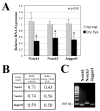Glycogene expression in conjunctiva of patients with dry eye: downregulation of Notch signaling
- PMID: 19011014
- PMCID: PMC2693254
- DOI: 10.1167/iovs.08-2734
Glycogene expression in conjunctiva of patients with dry eye: downregulation of Notch signaling
Abstract
Purpose: Glycoconjugates regulate a variety of biological events in mucosal surfaces, such as differentiation of postmitotic epithelial cells and maintenance of the wet-surfaced phenotype. This study aimed to identify the repertoire of genes (glycogenes) involved in biosynthesis of glycoconjugates in conjunctiva of normal subjects and patients with dry eye.
Methods: RNA from conjunctival impression cytology samples was amplified and hybridized to a custom-designed glycogene microarray. Intensity data were converted to expression values and analyzed by ANOVA. Microarray data for selected Notch glycogenes were confirmed by quantitative real-time PCR. Notch receptors and ligands were immunolocalized on conjunctival biopsies by confocal microscopy.
Results: By microarray, 424 glycogenes were identified in normal conjunctival epithelium; galectins, glycosyltransferases, mucins, Notch signaling molecules, and proteoglycans were among the most highly expressed. In dry eye, 46 glycogenes were significantly downregulated, including five members of the Notch signaling pathway (Notch1, Notch 2, Notch 3, Jagged1, Delta1), four Wnt signaling molecules (Wnt4, -5A, Frizzled6, -7), and three heparan sulfate glycotransferases (HS2ST1, HS3ST6, EXTL2). Only interferon-induced transmembrane protein 1 was upregulated. By real-time PCR, expression ratios of Notch1, Notch 3, and Jagged1 in dry eye were 0.43, 0.56, and 0.50, respectively, compared to controls (P < 0.05). Notch1, Notch3, and Jagged1 were immunolocalized throughout the conjunctival epithelium, whereas Notch2 and Delta1 were distributed apically.
Conclusions: This study revealed the differential glycogene expression profiles in normal subjects and patients with dry eye. Downregulation of Notch signaling in dry eye may result in abnormal differentiation of the conjunctival epithelium and have implications in the pathogenesis of the disease.
Figures



References
Publication types
MeSH terms
Substances
Grants and funding
LinkOut - more resources
Full Text Sources
Research Materials
Miscellaneous

